

RINO AMICO SCIENZIATO: GLI ANIMALI. Biomes by Amy Baggett - Book Creator.
SPaG LOLz Archives - Beano for Schools. Materiali didattici. OER. Risorse interattive per la chimica. Segnalo ctinteractives, un sito web costruito per utilizzare risorse didattiche interattive nel'insegnamento /apprendimento della chimica.
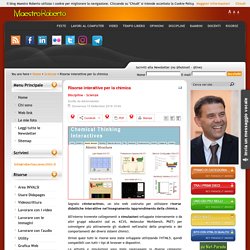
All'interno troverete collegamenti a simulazioni sviluppate internamente o da altri gruppi educativi (ad es. KCVS, Molecular Workbench, PhET) per coinvolgere più attivamente gli studenti nell'analisi delle proprietà e dei comportamenti dei diversi sistemi chimici. Ormai quasi tutti le risorse sono state sviluppate utilizzando l'HTML5, quindi compatibili con tutti i tipi di browser e dispositivi. Le attività e simulazioni sono state raggruppate in diverse categorie: struttura dell'atomo, legami chimici, struttura della molecola, reazioni, termodinamica, cinetica.
GEOGRAFIA. We. Inclusione. Vérification de sécurité nécessaire. Paxi: l'astronomia spiegata ai bambini. Paxi è un progetto realizzato dall'ESA (Agenzia Spaziale Europea) per spiegare l'astronomia ai bambini.

All'interno del portale ESA Kids è possibile scoprire un simpatico extraterrestre in grado di guidare i bambini alla scoperta di pianeti e stelle, ma anche dei rischi ambientali che stiamo correndo. Potrete trovare approfondimenti sulla formazione dell'Universo, su fenomeni come la forza di gravità, sul Sistema solare, sul mistero della morte dei dinosauri, sulle comete e molto altro ancora. Scienze e tic. Periodic Table of the Elements, in Pictures and Words. Water. CS Unplugged.
DIDATEC – Didattica e tecnologie. Dai poligoni regolari a Kandinsky. Teacher Resources PreK-College. Attività didattiche da The Children's University of Manchester. The Children's University of Manchester è un grande ambiente di condivisione di attività didatiche ed esperienze di apprendimento.
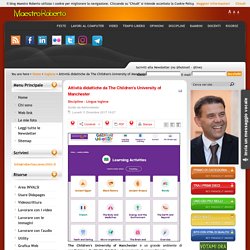
Sono disponibili contenuti di apprendimento, proposti in modalità interattiva online, da utilizzare su LIM, computer, tablet e altri dispositivi mobili. Il team di The Children's University of Manchester collabora con alcune scuole primarie locali, a supporto di insegnanti e alunni, favorendo la condivisione in rete delle buone pratiche promosse. La sezione Learning Activities permette di ricercare lezioni interattive, scegliendo tra varie sezioni: Parole, Antico Egitto, Antica Grecia, il corpo umano, Energia e ambiente, La Terra e gli altri pianeti, il cervello ed altro ancora.
ITALIANO-ANTOLOGIA. A List of 16 Websites Every Teacher should Know about. Educational Resources. Revised Blooms Taxonomy Action Verbs. How to use Bloom's taxonomy to create activities, assignments, and discussion questions. Quizlet. The concept of learning objectives is based largely on the work of Benjamin Bloom who worked with a group of educational psychologists in 1956 to create a taxonomy of instructional objectives based on a hierarchical classification of forms of learning.
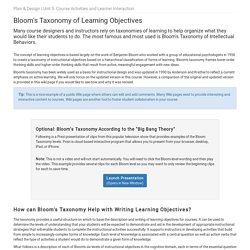
Bloom’s taxonomy frames lower-order thinking skills and higher-order thinking skills that result from active, meaningful engagement with new ideas. Bloom's taxonomy has been widely used as a basis for instructional design and was updated in 1990 by Anderson and Krathal to reflect a current emphasis on active learning. We will only focus on the updated version in this course. However, a comparison of the original and updated version is provided in this wiki page if you would like to see how and why it was revised. Active Learning. Research suggests that audience attention in lectures starts to wane every 10-20 minutes.
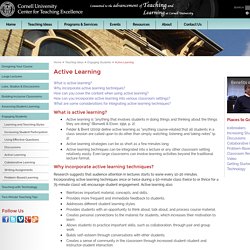
Incorporating active learning techniques once or twice during a 50-minute class (twice to or thrice for a 75-minute class) will encourage student engagement. Active learning also: Implementing any new teaching technique can be a daunting or challenging task. Some students may not accept new learning activities with complete ease.
Rather than trying to engage all students, focus on engaging more students in more meaningful ways. Angelo, T.A. & Cross, K.P. (1993). Problem-Based Learning. CTI - Collaborative Learning. What is collaborative learning?
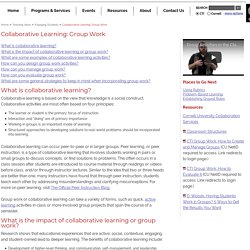
What is the impact of collaborative learning or group work? What are some examples of collaborative learning activities? How can you design group work activities? Elements of Lesson Design. Lesson Development | Lesson Planning Dr.

Madeline Hunter's research indicates that effective teachers usually include the following elements in their lessons. Micro-research: An Approach to Teaching and Learning. At its simplest, Micro-research (also known as Inquiry-based Learning) involves getting students to undertake a relatively small research project and report back to their peers.

The purpose of the approach is to encourage students to develop a deeper understanding of the material they have been researching while also developing skills that will be useful for other parts of the study and their eventual careers, such as critical thinking and evaluation, communication and presentation skills and information literacy skills. The approach challenges students to move towards becoming independent and autonomous learners by requiring them to find their own answers, rather than relying on their tutors supplying the necessary information. How it Works Typically a Micro-research activity would involve the students either being assigned or choosing a topic and undertaking a brief, but systematic, investigation into it before eventually presenting their findings in some way to their peers.
Sample Lesson Plans to Teach Common Core State Standards. Mathematics Lesson Plans Adding and Regrouping Build conceptual understanding and solve multi-digit addition problems with visual models and manipulatives.Finding Common Denominators By working with visual models students will explore the relationship between equivalent fractions and common denominators, and then apply their conceptual understanding to help them solve problems involving the addition and subtraction of fractions with unlike denominators.Adding and Subtracting Fractions Add and subtract fractions and build a conceptual understanding of the process with visual models.Tessellations Students will work with visual models to develop an understanding of tessellations and shapes that tessellate, review the names of polygons and explore shape composition.Word Problems: Step by Step Solve word problems visually with a sequential, step-by-step approach.

Blendspace. MTF2201233. DocsTeach.